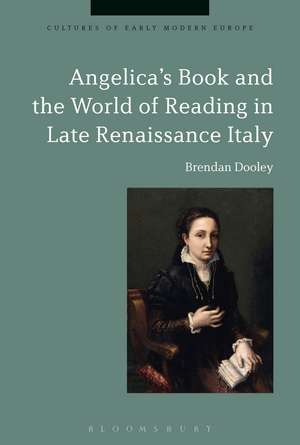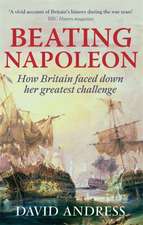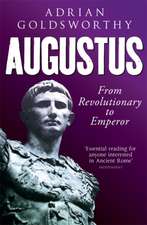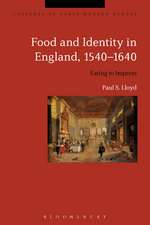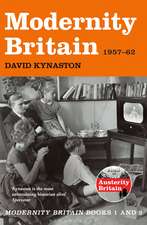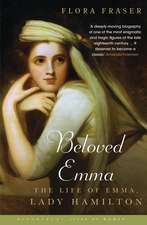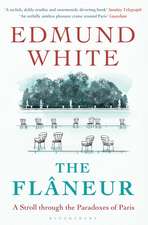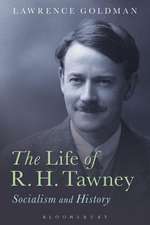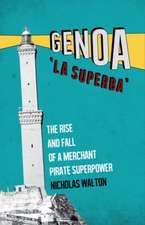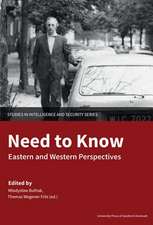Angelica's Book and the World of Reading in Late Renaissance Italy: Cultures of Early Modern Europe
Autor Professor Brendan Dooleyen Limba Engleză Paperback – 18 apr 2018
| Toate formatele și edițiile | Preț | Express |
|---|---|---|
| Paperback (1) | 236.54 lei 6-8 săpt. | +85.52 lei 5-11 zile |
| Bloomsbury Publishing – 18 apr 2018 | 236.54 lei 6-8 săpt. | +85.52 lei 5-11 zile |
| Hardback (1) | 772.98 lei 6-8 săpt. | |
| Bloomsbury Publishing – 19 oct 2016 | 772.98 lei 6-8 săpt. |
Preț: 236.54 lei
Preț vechi: 305.12 lei
-22% Nou
Puncte Express: 355
Preț estimativ în valută:
45.26€ • 47.38$ • 37.67£
45.26€ • 47.38$ • 37.67£
Carte tipărită la comandă
Livrare economică 31 martie-14 aprilie
Livrare express 22-28 februarie pentru 95.51 lei
Preluare comenzi: 021 569.72.76
Specificații
ISBN-13: 9781350067134
ISBN-10: 135006713X
Pagini: 216
Ilustrații: 12 BW Illus
Dimensiuni: 156 x 234 x 14 mm
Greutate: 0.3 kg
Ediția:NIPPOD
Editura: Bloomsbury Publishing
Colecția Bloomsbury Academic
Seria Cultures of Early Modern Europe
Locul publicării:London, United Kingdom
ISBN-10: 135006713X
Pagini: 216
Ilustrații: 12 BW Illus
Dimensiuni: 156 x 234 x 14 mm
Greutate: 0.3 kg
Ediția:NIPPOD
Editura: Bloomsbury Publishing
Colecția Bloomsbury Academic
Seria Cultures of Early Modern Europe
Locul publicării:London, United Kingdom
Caracteristici
Explores issues relating to the possibilities and limitations of historical evidence, as well as issues relating to the historical subject in question
Notă biografică
Brendan Dooley is Professor of Renaissance Studies at University College Cork, Ireland. His numerous publications include A Mattress Maker's Daughter: The Renaissance Romance of Don Giovanni de' Medici and Livia Vernazza (2014), Morandi's Last Prophecy and the End of Renaissance Politics (2002) and, as author/ editor, The Dissemination of News and the Emergence of Contemporaneity in Early Modern Europe (2010).
Cuprins
List of IllustrationsPrefaceIntroduction1. Straparola and Late Renaissance Publishing2. The Trials of Literature in an Age of Censorship3. A Woman's Hand4. Angelica and her Book5. Reading and Gender6. Book Conservation and the Digital TurnConclusionNotesSelect BibliographyIndex
Recenzii
Angelica's Book has considerable charm, and may lure that wide audience of educated but nonspecialist readers that scholarly books seek but often miss . the prose has a freshness that academic histories tend to lack . an intriguing and provocative narrative.
Through the common thread that lies between a book and its reader, Dooley artfully takes us into a dusty, hidden world. (Bloomsbury Translation)
This book adds a most precious chapter to the history of books and reading in the early modern period. Dooley has the very rare virtue of combining scholarly exactitude and methodological intelligence with narrative entertainment. Angelica's Book represents not just a splendid piece of research and a riveting account, but helps everyone to understand the crucial importance of the humanities in our world.
Angelica's Book approaches the discipline of book history as a path rather than a territory, using a single book artefact to offer close views of the lives and places it touched. Author and owner are joined by a rich cast of printers, censors, merchants, tutors, critics, literary inspirations, powerful patrons, and feuding princes, whose intertwining stories combine to show the rich fabric of Renaissance life. With its vivid authorial presence and prose more tender than clinical, Angelica's Book presents a double narrative of the parallel encounters with a book experienced by the Renaissance world on the one hand, and a modern scholar on the other. Yet it is also deeply engaged with context, providing a richer understanding of the intricate world which the book's meandering encounters demonstrate. Dooley shows how the simple acts of owning and reading were affected by period approaches to sexuality, education, religion, gender, honor, and the many kinds of power, institutional and intellectual, at play in the deceptively simple arena of the Renaissance printed page.
Ambitiously inspired . [The] world of reading in Renaissance Italy . is deftly fleshed out by informed treatments of topics like the circulation of news, women's book ownership, mnemonic techniques, storytelling practices, and censorship.
Illuminating ... Dooley offers fascinating insights.
Through the common thread that lies between a book and its reader, Dooley artfully takes us into a dusty, hidden world. (Bloomsbury Translation)
This book adds a most precious chapter to the history of books and reading in the early modern period. Dooley has the very rare virtue of combining scholarly exactitude and methodological intelligence with narrative entertainment. Angelica's Book represents not just a splendid piece of research and a riveting account, but helps everyone to understand the crucial importance of the humanities in our world.
Angelica's Book approaches the discipline of book history as a path rather than a territory, using a single book artefact to offer close views of the lives and places it touched. Author and owner are joined by a rich cast of printers, censors, merchants, tutors, critics, literary inspirations, powerful patrons, and feuding princes, whose intertwining stories combine to show the rich fabric of Renaissance life. With its vivid authorial presence and prose more tender than clinical, Angelica's Book presents a double narrative of the parallel encounters with a book experienced by the Renaissance world on the one hand, and a modern scholar on the other. Yet it is also deeply engaged with context, providing a richer understanding of the intricate world which the book's meandering encounters demonstrate. Dooley shows how the simple acts of owning and reading were affected by period approaches to sexuality, education, religion, gender, honor, and the many kinds of power, institutional and intellectual, at play in the deceptively simple arena of the Renaissance printed page.
Ambitiously inspired . [The] world of reading in Renaissance Italy . is deftly fleshed out by informed treatments of topics like the circulation of news, women's book ownership, mnemonic techniques, storytelling practices, and censorship.
Illuminating ... Dooley offers fascinating insights.
